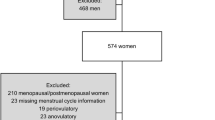Abstract
Background: Low levels of sex hormones, especially progesterone, are suspected as a risk factor for sleep-disordered breathing (SDB). Objective: To test the hypothesis that serum levels of progesterone, estradiol, and 17-OH progesterone are lower in those women with clinically significant SDB. Design: Clinical cohort of convenience. Setting: University Hospital Sleep Laboratory. Methods: We investigated sleep and breathing parameters and serum levels of sex hormones in 53 consecutive women (ages 24 to 72 years) being evaluated for symptoms of daytime sleepiness. Analysis of hormonal status by specific radioimmunoassays and fluorescence immunoassays was done from blood samples taken after an overnight polysomnography. Results: Across the cohort, taking account of age and cycle time or postmenopausal status, those with an apnea-hypopnea index (AHI) greater than 10/hrs of sleep had significantly lower levels of 17-OH progesterone, progesterone, and estradiol than those with an AHI less than 10. Conclusion: We conclude that reductions in female sex hormones are associated with an increased probability of SDB in women with daytime sleepiness.
Similar content being viewed by others
Explore related subjects
Discover the latest articles and news from researchers in related subjects, suggested using machine learning.References
Popovic RM, White DP. Upper airway muscle activity in normal women: influence of hormonal status. J Appl Physiol 1998;84:1055–1062
White D, Douglas N, Pickett C, Weil J, Zwillich C. Hypoxic ventilatory response during sleep in normal premenopausal women. Am Rev Respir Dis 1982;126:530–553
Regenstein QR. Sleep apnea in menopause. Menopause 1999;6:186–187
Jordan AS, Catcheside PG, O’Donoghue FJ, Saunders NA, McEvoy RD. Genioglossus muscle activity at rest and in response to brief hypoxia in healthy men and women. J Appl Physiol 2002;92:410–417
Jordan AS, Catcheside PG, O’Donoghue FJ, Saunders NA, McEvoy RD. Ventilatory decline after hypoxia and hypercapnia is not different between healthy young men and women. J Appl Physiol 2000;88:3–9
Dancey DR, Hanly PJ, Soong C, Lee B, Hoffstein V. Impact of menopause on the prevalences and severity of sleep apnea. Chest 2001;120:151–155
Thurnheer R, WraithPK, Douglas NJ. Influence of age and gender on upper airway resistance in NREM and REM sleep. J Appl Physiol 2001;90:981–988
Zhou XS, Shahabuddin S, ZahnBR, Babcock MA, Badr MS. Effect of gender on the development of hypocapnic apnea/hypopnea during NREM sleep. J Appl Physiol 2000;89:192–199
Young T, Palta M, Dempsey J, Skatrud J, Weber S, Badr S. The occurrence of sleep-disordered breathing among middle-aged adults. N Engl J Med 1993;328:1203–1205
Redline S, Kump K, Tishler PV, BrownerI, Ferrett V. Gender differences in sleep-disordered breathing in a community-based sample. Am J Respir Crit Care Med 1994;149:722–726
Kripke DF, Ancoli-Israel S, KlauberMR, Wingard DL, Mason WJ, Mullaney DJ. Prevalence of sleep-disordered breathing in ages 40–64 yrs: a population-based survey. Sleep 1997;20:65–76
Young T, Shahar E, NietoFJ, et al. Predictors of sleep-disordered breathing in community-dwelling adults: the Sleep Heart Health Study. Arch Intern Med 2002;162:893–900
Block AJ, Wynne JW, Boysen PG. Sleep-disordered breathing and nocturnal oxygen desaturation in postmenopausal women. Am J Med 1980;69:75–79
Gislason T, Benediktsdottir B, Björnsson JK, KjartanssonG, Kjeld M, Kristbjarnarson H. Snoring, hypertension, and the sleep apnea syndrome: an epidemiologic survey of middle-aged women. Chest 1993;103:1147–1151
Bixler EO, Vgontzas AN, Lin HM, et al. Prevalence of sleep-disordered breathing in women. Am J Respir Crit Care Med 2001;163:608–613
Cheryl KP, Regensteiner JG, Woodward WD, Hagerman DD, Weil JV, Moore LG. Progestin and estrogen reduce sleep-disordered breathing in women. J Appl Physiol 1989;66:1656–1661
Cistulli PA, Barnes DJ, Grunstein RR, Sullivan CE. Effect of short-term hormone replacement in the treatment of obstructive sleep apnea in postmenopausal women. Thorax 1994;49:699–702
Montplaisir J, Lorrain J, Denesle R, Petit D. Sleep in menopause: differential effects of two forms of hormone replacement therapy. Menopause 2001;8:10–16
American Academy of Sleep Medicine Task Force Report. Sleep-related breathing disorders in adults: recommendations for syndrome definition and measurement techniques in clinical research. Sleep 1999;22:667–689
Young T. Menopause, hormone replacement therapy, and sleep-disordered breathing: are we ready for the heat?. Am J Respir Crit Care Med 2001;163:597–598
Author information
Authors and Affiliations
Corresponding author
Rights and permissions
About this article
Cite this article
Netzer, N.C., Eliasson, A.H. & Strohl, K.P. Women with Sleep Apnea Have Lower Levels of Sex Hormones. Sleep Breath 7, 25–29 (2003). https://doi.org/10.1007/s11325-003-0025-8
Issue Date:
DOI: https://doi.org/10.1007/s11325-003-0025-8




